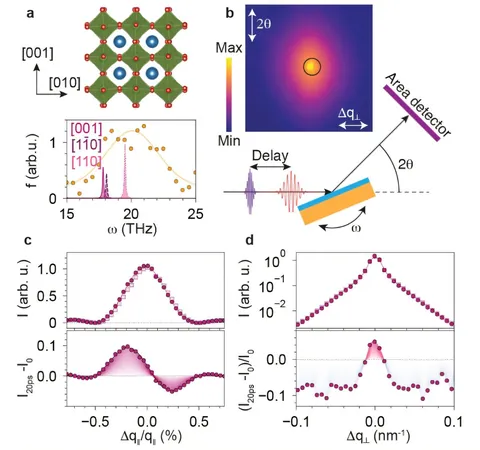
Unlocking the Secrets of Ultrahigh-Speed 'Breathing' in Materials with Infrared Light
2025-09-15
Author: Benjamin
Cornell Researchers Achieve Breakthrough in Material Manipulation
In a groundbreaking study, researchers from Cornell Engineering have harnessed the power of ultrafast infrared light pulses to make synthetic thin films 'breathe' at an astonishing rate. This phenomenon involves the atomic lattice expanding and contracting billions of times per second, opening up new possibilities for rapidly toggling a material's electronic, magnetic, or optical properties.
The Power of Light in Material Science
Traditionally, manipulating materials to induce strain has relied on mechanical methods, like stretching and compressing. However, using light to achieve these effects has not been extensively explored. Nicole Benedek, an associate professor of materials science and engineering, pointed out the complexities involved in understanding how materials interact with light: "Whenever you try to do anything with light, it immediately becomes very complicated." By leveraging computational theory, Benedek and her team identified the ideal light frequency and conditions to induce a reversible strain.
Dynamic Strain: A New Approach to Material States
Unlike typical strains that are fixed after material synthesis, this innovative method creates a fleeting dynamic strain that can quickly reshape the material. The researchers achieved this by targeting the lattice vibrations known as phonons with incredibly precise bursts of terahertz light.
Key Insights from the Experiment
As co-lead author Andrej Singer explained, "We tune the frequency and excite specific atomic motions, resulting in rapid lattice expansion." This technique was effective due to the choice of lanthanum aluminate, a seemingly mundane material that proved to be the perfect candidate for experimentation. The team, guided by Darrell Schlom, synthesized this material using advanced techniques.
A Surprising Outcome: Permanent Structural Changes
In addition to inducing temporary strain, the researchers found that their approach permanently enhanced the material's structural integrity. The excited phonons led to the formation of a more crystalline and well-ordered structure, propelling the film into a new material state that had not been previously achievable.
Implications for Future Technologies
This breakthrough could revolutionize the way materials are engineered, allowing for on-demand switching of electronic and magnetic properties, and enabling sophisticated applications like superconductivity. Benedek and Singer's collaborative approach, merging theory, synthesis, and characterization, sets the stage for exciting advancements in manipulating the properties of complex-oxide materials.









 Brasil (PT)
Brasil (PT)
 Canada (EN)
Canada (EN)
 Chile (ES)
Chile (ES)
 Česko (CS)
Česko (CS)
 대한민국 (KO)
대한민국 (KO)
 España (ES)
España (ES)
 France (FR)
France (FR)
 Hong Kong (EN)
Hong Kong (EN)
 Italia (IT)
Italia (IT)
 日本 (JA)
日本 (JA)
 Magyarország (HU)
Magyarország (HU)
 Norge (NO)
Norge (NO)
 Polska (PL)
Polska (PL)
 Schweiz (DE)
Schweiz (DE)
 Singapore (EN)
Singapore (EN)
 Sverige (SV)
Sverige (SV)
 Suomi (FI)
Suomi (FI)
 Türkiye (TR)
Türkiye (TR)
 الإمارات العربية المتحدة (AR)
الإمارات العربية المتحدة (AR)